About five years ago, my husband and I began considering international adoption. We had two biological daughters, yet we both started feeling like our family wasn’t complete. During that time we researched many countries and decided China’s program would be the best fit for our family. However, the process was daunting and there was still the question of what if I got pregnant? Was it the right time? A few years passed and it became increasingly clear that adoption was the right path for our family.
By the summer of 2015 we were praying about officially moving forward, and that September we started our homestudy and dossier preparation. We planned to send our dossier to China and be matched with a child with “minor needs” whose file would only be available to families with dossiers logged-in (LID).
The diagnosis of microtia (a congenital condition in which the outer ears do not form or fully develop and is typically associated with aural atresia, or absence of the external ear canal) was a need we checked on our medical needs checklist. We also planned to adopt a girl.
Initially I had always envisioned adopting a little boy, but we eventually decided a girl would be best for our family. We had girls already, we knew girls, etc. It just made sense, right? But along the way I started reading more and more stories about how great the need was for families open to boys. The reality is that most families will choose to adopt a girl, so many boys wait to be chosen. I started bringing it up to our family, and our hearts began to open up to the idea of adopting a boy.
One evening in June 2016, I decided to check the waiting child page on our agency’s website. These were children who were listed as Special Focus instead of LID, meaning they had needs that were generally harder to place. That’s when I saw his sweet picture. I was able to access his file and couldn’t believe his special need was the one I was hoping to be matched with – microtia! Originally we were only open to unilateral microtia with hopefully normal hearing on the unaffected side. But, after seeing his face, bilateral microtia didn’t seem so scary after all.
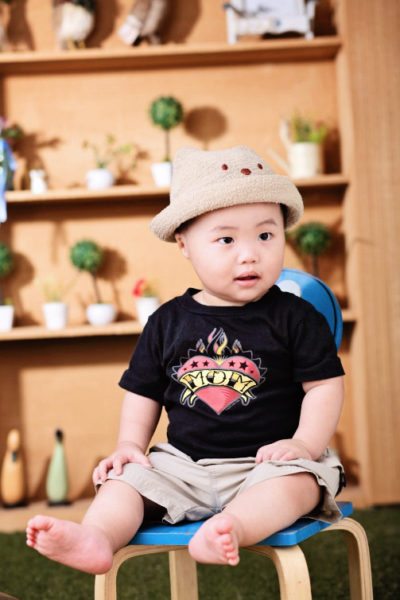
Still, his file was full of unknowns and was a bit outdated. In addition to his microtia/atresia he had some significant developmental delays. Plus we hadn’t considered adopting a child with significant hearing loss. We knew very little sign language and weren’t sure if we were prepared. But I had researched bone anchored hearing aids (BAHA) as a possibility for managing hearing loss for people with microtia, and I couldn’t let this boy go.
We decided to have his file reviewed by Dr. Staat at Cincinnati Children’s Hospital. Because he was listed as Special Focus, we were able to request an update that would hopefully include more recent information and video of his abilities.
The wait for the update was agonizing and we had no clear timeline of when it would come. One Sunday evening, some friends in our neighborhood (and adoptive parents) stopped by to check in. They understood what we were going through and asked to come in and pray for us. We stood in a circle holding hands as they prayed for his update to come, and for God to be in control of the situation.
What I later realized was that as that prayer was spoken, our son’s update was being prepared on Monday morning in China. Wow! I opened the email Tuesday morning and saw our sweet boy. There are always unknowns and adoption is such a leap of faith, but with Dr. Staat’s insight we felt informed about the range of outcomes our boy may have.
I cannot emphasize enough how beneficial it was to have his file reviewed by an expert in the field of international adoption. We gained the clarity we had prayed for, and had a peace that this boy was ours.
The next three months were a blur of packing, preparation and worry. But each time my mind would venture into the what-ifs I would pray, and that same peace would come over me.
The day we met our son in China was incredible. I had seen plenty of gotcha day videos and prepared myself and our family that he would cry, possibly fight, and be generally terrified. I also prepared myself that it was okay if I didn’t feel an immediate connection.
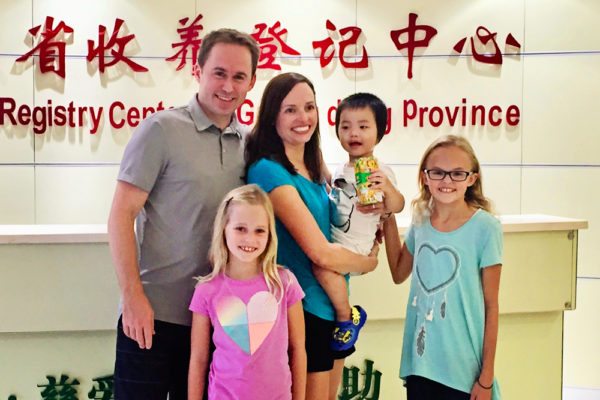
When he walked into the room he looked so serious and very much alone. We knelt down and showed him some toys, being careful not to overwhelm him. After a few minutes our guide suggested I try to pick him up. I was worried I would scare him, but when I reached out and picked him up he wrapped his sweet little arms and legs around me and didn’t let go. In that moment I felt the hand of God reassure me, sort of like, “See? I told you!” I have never felt closer to God. Meeting our son was just as powerful as the birth our daughters. We truly loved him immediately and were so thankful we didn’t let fear get in the way of finding our son.
One of our big questions before meeting him was how we would communicate. We found out that his foster family spoke a local dialect, so translation apps were not helpful. We also weren’t sure how much he was hearing. How would we be able to meet his needs? Amazingly, we didn’t have a problem knowing what he needed. He made his needs known!
As he became more comfortable with us, we started hearing his sweet voice. No real words yet, but sounds and lots of giggles. Before long he learned to say “mama” and “more”. What a joy to hear him speak!
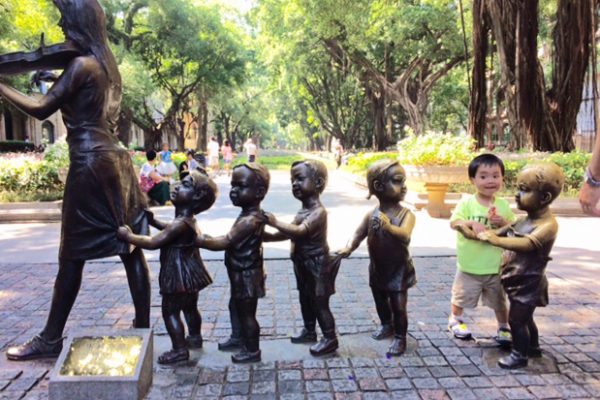
Prior to leaving for China I scheduled his first audiology appointment. Less than a week after we arrived home he participated in an audiology evaluation. It was confirmed that he did have cochlear function and was hearing at about 50 dBL. He could hear some conversation, but language was very muffled and many sounds were not clear.
Providing hearing aids was the best option for him to learn spoken language and be able to function with near normal hearing. Two weeks later he was fitted with a loaner BAHA or bone anchored hearing aid. These types of hearing aids are worn on a softband and allow sound to bypass the ear canals and be sent to the cochleas via bone conduction. Once young children are a bit older the devices can be attached to a surgically implanted abutment, eliminating the need for the softband. The device he trialed was an Oticon Ponto Plus.
We weren’t sure what to expect the first time he tried on the device. He was very still and serious and there was no big reaction. We were advised to encourage him to wear it for a few hours as tolerated. It turned out that he never tried to take it off! We got some huge smiles that day! We were amazed when he looked up in the sky at the sound of an airplane for the first time. He could even hear the birds chirping!
In early February, he was fitted with his very own Oticon Ponto 3 Super Power hearing aids. He wears two because even though one will stimulate both cochleas, it will not allow a person to differentiate where sound is coming from. Having two allows him to hear as normally as possible and localize sounds.
Before China I knew some very basic signs and once we met him we started incorporating signs like “eat” and “more” into our daily routine. Within a few months and with the help of many “Signing Time” episodes, we were all utilizing signs with spoken language.
With the help of an early intervention developmental specialist and a hearing intervention specialist through Help Me Grow, we learned ways to encourage him to vocalize. They explained that he was essentially a newborn in terms of hearing, and that his speech would develop very much like a baby. Sure enough he began lots of babbling and his language development mirrored many of the ways our daughters learned to speak.
He’s been home for 13 months and has now progressed to putting together three and four word sentences! His articulation is a work in progress and there are several letter sounds he has not mastered. However his speech has truly taken off and will likely be close to age level in the next few years.
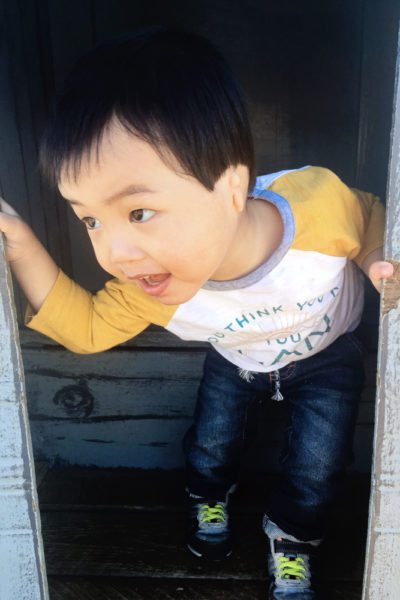
He receives speech therapy at preschool and is making huge progress. His speech therapist explained that just being in the classroom is extremely beneficial because around 80% of language/vocabulary is learned through incidental listening, and not through one to one speech instruction. As he continues to develop his vocabulary, he will benefit from ongoing speech therapy for articulation.
Physically he has caught up to his age level. Although he was wobbly with low muscle tone in China, he is now extremely strong with good coordination. Those delays were likely institutional and did not require PT or OT once home, just lots of playing, climbing and swinging.
His day to day life is much like any other three year old. When he wakes up, he puts on his softband with his Pontos, and that’s it! I change the batteries once a week, and he takes it off at bedtime. We now go every 6 months for audiology appointments to monitor his hearing and to assess his progress with auditory comprehension.
Practical considerations for managing microtia include checking insurance coverage for speech and audiology services, as well as coverage for hearing aids. Interestingly, BAHA devices are coded as durable medical equipment and not hearing aids. This is really important because many insurance companies offer no coverage for hearing aids. Before calling the insurance company, check with an audiology office for the medical code of the BAHA.
In addition to insurance, our local children’s hospital offers a grant to pay for a child’s first hearing aid if they are under 3 years old. I have also learned of a county adoption subsidy that helps pay for medical expenses. It’s worth researching what may be available so that you can be prepared financially. Down the road we will pursue possible ear reconstruction and even canal surgery, which can sometimes restore hearing.
What I would tell others considering this need is that you need to be open to significant hearing loss regardless of the hearing tests in a file. Management could look very different depending on the child and the resources available. While we chose to pursue hearing interventions and spoken language, others may choose ASL and/or a deaf education community. Thankfully there are so many resources and options available.
Most importantly, our son’s need does not define him. In fact we often don’t even think about it! He is incredibly smart, empathetic, loving, hilarious, and strong. He just needed his full potential to be unlocked. The thought of not having him here makes my heart ache.
Has adoption been easy? No way. We work through lots of challenges including sleep and food issues, evolving sibling relationships, attachment, and the daily efforts of connected parenting. But he is worth every second of the hard work and has blessed our family more than we could have dreamed. The fact that we could have missed this if we had only been open to adopting a girl is hard to comprehend. He is truly loved and cherished.
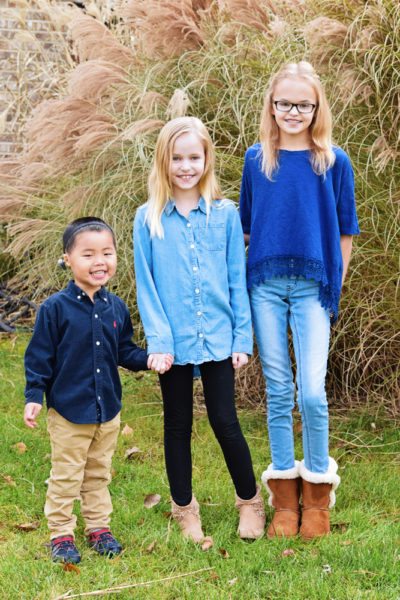
We are no different than all the other families striving to meet the needs of three very different children. We just chose to trust God and follow this path. As I began writing this article we were contacted about another sweet boy in China who needs a family. Were we planning to go back this soon? Not really. But in God’s perfect timing mountains have moved.
So we are taking our own advice and stepping out in faith once more. In the coming year, we plan to travel to China for one more precious boy. God has shown us that He will make a way, and we have had the honor to experience first-hand how God doesn’t call the equipped, he equips the called.
Resources:
Signing Time
Ear Community
– guest post by Meredith

























Leave a Reply